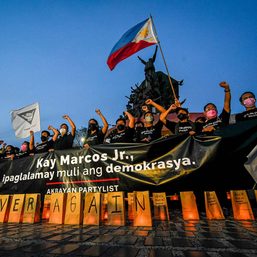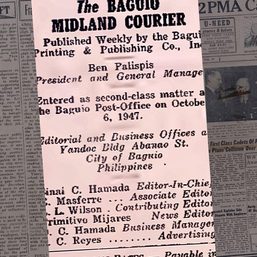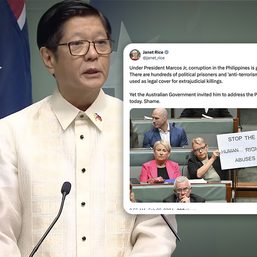SUMMARY
This is AI generated summarization, which may have errors. For context, always refer to the full article.
![[OPINION] Truthtelling about the Marcos family, Cory, and FVR](https://www.rappler.com/tachyon/2022/08/TL-truth-justice-marcoses-ramos-aquino-August-12-2022.jpg)
In an age where the Marcoses are back in the Palace and Imelda can say, “Perception is real; truth is not,” we continue to look for the truth about the dictator and his family. But the Marcoses regaining power makes it particularly more difficult to find the truth when perception, personality, and propaganda seem to matter more.
One we could say that fits this idea of valuing perception over truth is the recently released movie Maid in Malacañang (MiM) by Darryl Yap. Maid in Malacañang, according to its synopsis, shares an “untold story” of the Marcoses before they fled to Hawaii during the 1986 People Power Revolution – the last 72 hours of the family in Malacañang Palace to be exact. Even before its release, the film has been a popular and controversial topic on the internet. From director Darryl Yap being deemed “problematic” by netizens for questionable directorial choices to Ella Cruz as Irene Marcos claiming that history is from “chismis.” However, more than controversial personalities working on this movie, it appears as a blatant attempt to distort history and restore the “Marcos legacy.” Imee Marcos who was a producer of the film stated herself, “Ang importante, ’yung maahon namin ang pangalan namin, ang apelyido namin, na ’yung legacy ng tatay ko babalikan at titingnan nang maigi.”
Just from the trailer, it already paints the Marcoses as a family to sympathize with. They are being chased away from their “home” by an angry mob and they are seemingly helpless. It also shows Imelda Marcos dramatically looking at her shoe collection as if she’s parting with her children. It exhibits Marcos Sr. as a compassionate leader as he argues with his son Bongbong, “So ang gusto mo pasabugan din natin sila?” Finally, it shows Imee Marcos “saving” all of them from the Filipinos. As if they are the protagonists while the people are the antagonists. Most reviews from publications who do not identify as Marcos apologists would point out the same things and more.
Film, perception, and truth
What is clear from Maid in Malacañang is that it follows the idea that perception is real while the truth is not. It humanizes the Marcoses who have stolen from and abused the Filipino people by painting them as characters who do not reflect what they have done to the Philippines. People have slammed this movie as an attempt to distort history but the MTRCB has defended it, saying that the film does not identify as a documentary. Hence, there is no basis for this accusation. However, MiM itself claims to tell an “untold truth” and doesn’t every artwork attempt to outline some sort of truth whether particular or universal?
Unfortunately, we do not find the truth in the narrative of MiM. Instead, we see it in its form and project. MiM is a film that acts as pro-Marcos propaganda which imitates Marcos Sr.’s tactic during his regime – drilling the idea of Bagong Lipunan, painting himself and Imelda as Malakas and Maganda, censoring all media that went against their character. MiM does present a truth, just not in the way that it wants to. While nothing is wrong with perception, what is it if not supported by truth?
But amidst this malicious propaganda in an attempt to salvage their family’s character, it’s important to ask: What was it really like during Marcos Sr.’s regime? Where is that truth?
MiM vs Katips?
As an attempt to retaliate against the propaganda film MiM, Katips: the Movie by Vince Tañada was released at the same time MiM was. This movie was originally an award-winning play in 2016 called Katips: Ang Mga Bagong Katipunero, before being adapted to film in 2021 and released in 2022. Katips is a musical about a group of student activists who endured Martial Law and the Marcos regime while trying to continue to fight for what they believed in. While it is not perfect as netizens have critiqued and discussed the crafting of this film the past few days – from script to camera angles to accuracy of the movie – it remains to be a force able to fight MiM. Tañada himself has said that one project of his film is to educate a younger audience about the atrocities of Martial Law. And this is a good start, especially during a time of malevolent and widespread disinformation and historical distortion.
There is always room for critique and improvement, but as of now, we must also make space for the truth as Katips tells exactly that. It shows the violence behind a “sanitized” image of the Marcoses and Martial Law.
Katips and Maid in Malacañang both offer truths – Katips about the battle the Filipino people fought against oppression, and Maid in Malacañang about how the Marcoses continue to use propaganda to control their family’s image.
Truthtelling through Cory and FVR
Behind clear-cut, black and white truths, morality remains gray which brings us to two significant deaths (one recent and one on its 13th anniversary) of people closely relevant to the Marcos regime: Fidel V. Ramos and Cory Aquino.
Cory Aquino, who passed away on August 1, 2009, was undeniably one of the greatest figures attached to Marcos’ regime and its end. As the narrative says, she went from a widow to a leader of EDSA I to the president who finally replaced the dictator. The toppling of Marcos Sr. is a good thing in the absolute. However, Cory Aquino’s administration after is where things become gray. It is true that Cory Aquino was a key figure that led to the ousting of a dictator who tortured thousands of Filipinos. However, it is also true that there were numerous human rights violations under Cory Aquino, some of the most prominent ones being the Mendiola Massacre leading to the death of 13 farmers, and the 540 desaparecidos cases, the highest number after Marcos.
These two truths about Cory coexist and so morality appears gray. And that’s simply how it goes, what matters is that we have truths to support whatever perception we make of any person, especially leaders of our country. If anything, this only proves that it was never the Marcoses against the Aquinos. It was and is the Marcoses against the Filipino people.
Another key figure during the Marcos regime was Fidel V. Ramos (FVR) who passed away on July 31. FVR is also a morally gray Martial Law figure. During Marcos’ regime, he was the head of the Philippine Constabulary (PC) which was notorious for arresting, torturing, and murdering Filipinos, especially those from the opposition. However, despite working for Marcos, FVR was also one of the “leaders” during EDSA I. He turned his back on the Marcoses and went with the Filipino people to oust the dictator. He would later on be Cory Aquino’s defense secretary then a president himself. As a president, FVR was known for stabilizing the economy through his reforms; he also repealed the Anti-Subversion Law which was prone to red-tagging abuse.
These two key figures are far from being morally perfect. One moment they’re with the Filipino people, another they’re against the Filipino people. However, without dismissing their wrongs, we acknowledge that these two defying Marcos during People Power I was more than just a small part of the ousting.
FVR for one, some people believe, has served atonement through service after Martial Law which the Marcoses never did. And isn’t this why they continue to climb up the ladder? To restore their family’s name, to distort history, to hide the truth? Because they do not want to serve reparations. They cannot handle the justice that must be served with the truth.
But as we see now, as MiM is challenged by Katips, as the Marcoses were ousted by the Filipino people with the help of key figures, the fight for truth and justice continues. – Rappler.com
Tony La Viña teaches law and is former dean of the Ateneo School of Government.
Bernardine de Belen recently graduated from the Ateneo de Manila University with a Creative Writing degree. She has just joined Manila Observatory as a research assistant.
Add a comment
How does this make you feel?



![[Newspoint] The challenge of unsavory company](https://www.rappler.com/tachyon/2024/02/tl-unsavory-company.jpg?resize=257%2C257&crop=238px%2C0px%2C720px%2C720px)

![[Closer Look] ‘Join Marcos, avert Duterte’ and the danger of expediency](https://www.rappler.com/tachyon/2024/06/TL-trillanes-duterte-expediency-june-29-2024.jpg?resize=257%2C257&crop_strategy=attention)
![[Newspoint] A Freedom Week joke](https://www.rappler.com/tachyon/2024/06/20240614-Filipino-Week-joke-1.jpg?resize=257%2C257&crop_strategy=attention)





![[EDITORIAL] EDSA or no EDSA, padayon](https://www.rappler.com/tachyon/2023/02/animated-EDSA-panatang-makabayan-carousel.jpg?resize=257%2C257&crop=90px%2C0px%2C720px%2C720px)

![[DECODED] The Philippines and Brazil have a lot in common. Online toxicity is one.](https://www.rappler.com/tachyon/2024/07/misogyny-tech-carousel-revised-decoded-july-2024.jpg?resize=257%2C257&crop_strategy=attention)












![[OPINION] In the Philippines, the fight for the climate is a fight against state violence](https://www.rappler.com/tachyon/2024/02/imho-contexualizing-state-violence.jpg?resize=257%2C257&crop=265px%2C0px%2C720px%2C720px)


![[WATCH] In the Public Square with John Nery: The Marcoses’ three-body problem](https://www.rappler.com/tachyon/2024/04/pubsq-sq.jpg?resize=257%2C257&crop=390px%2C0px%2C1080px%2C1080px)
![[Newsstand] The Marcoses’ three-body problem](https://www.rappler.com/tachyon/2024/04/tl-marcoses-3-body-problem.jpg?resize=257%2C257&crop=451px%2C0px%2C1080px%2C1080px)
![[EDITORIAL] Kalaban mo ang mga senador na protektor ni Quiboloy](https://www.rappler.com/tachyon/2024/03/animated-quiboloy-kojc-senate-carousel.jpg?resize=257%2C257&crop=365px%2C0px%2C720px%2C720px)

![[Hindi ito Marites] First Lady Liza Marcos: Unofficial presidential spokesperson?](https://www.rappler.com/tachyon/2024/05/Hindi-ito-Marites-TC-ls-02.jpg?resize=257%2C257&crop_strategy=attention)









![[OPINION] Raised on radio](https://www.rappler.com/tachyon/2024/04/raised-on-radio.jpg?resize=257%2C257&crop=396px%2C0px%2C720px%2C720px)
![[Just Saying] Marcos: A flat response, a missed opportunity](https://www.rappler.com/tachyon/2024/04/tl-marcos-flat-response-april-16-2024.jpg?resize=257%2C257&crop=277px%2C0px%2C720px%2C720px)


There are no comments yet. Add your comment to start the conversation.